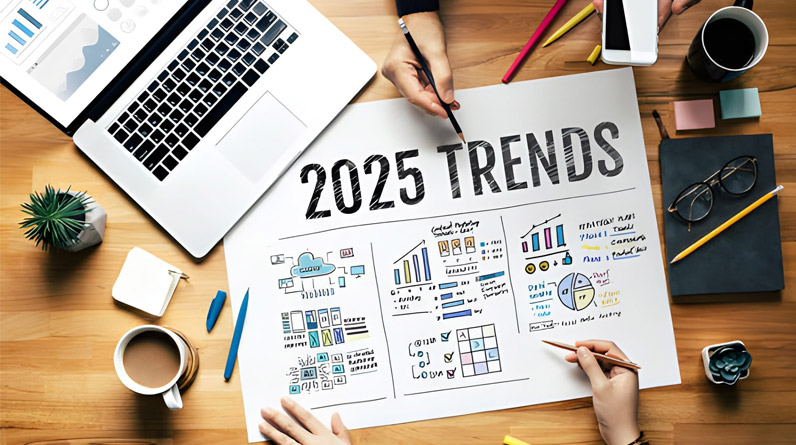The digital marketing landscape is undergoing its most dramatic transformation in decades. With consumers spending an average of 7 hours online daily and marketing budgets shrinking by 15% in 2024, businesses face a critical challenge: do more with less while meeting skyrocketing consumer expectations.
The stakes have never been higher. Companies that successfully navigate these changes are seeing remarkable results, with 48% of marketing personalization leaders exceeding their revenue goals. Meanwhile, those clinging to outdated strategies risk becoming invisible in an increasingly competitive digital ecosystem.
This comprehensive guide explores the most impactful digital marketing trends shaping 2025, offering actionable insights to help your business thrive in this new era.
The AI Revolution: From Buzzword to Business Imperative
Artificial intelligence has officially graduated from experimental technology to essential business tool. In 2025, 82% of agencies have integrated AI into their workflows, and the results speak for themselves.
How AI is Transforming Marketing Operations
AI is no longer just about automating repetitive tasks. It is fundamentally changing how businesses understand and engage with customers:
- Predictive Customer Journeys: AI algorithms analyze behavioral patterns to anticipate customer needs before they even search, enabling proactive rather than reactive marketing.
- Dynamic Content Generation: Tools like ChatGPT and Jasper help marketing teams produce content at scale while maintaining quality, freeing human creativity for strategic thinking.
- Real-Time Personalization: AI processes customer data instantly to deliver hyper-relevant experiences across every touchpoint, from email to website to advertisements.
Example: A leading e-commerce brand implemented AI-powered product recommendations and saw a 40% increase in conversion rates within three months, with customers spending 35% more time on their platform.
The Strategic Advantage
With 81.3% of agency professionals identifying AI as the biggest trend for the next decade, early adopters are gaining significant competitive advantages. However, marketers must remain vigilant about AI’s limitations, including potential biases in training data and ongoing privacy concerns.
First-Party Data: Your Most Valuable Asset
As third-party cookies fade into obsolescence and privacy regulations tighten globally, first-party data has become the foundation of successful digital marketing.
| Data Strategy Investment | Percentage of CMOs |
|---|---|
| Customer Data Platforms (CDPs) | 32.6% |
| Strategic Agency Partnerships | 29.1% |
| Reducing Internal Data Silos | 29.1% |
Building Trust Through Transparency
Consumers are increasingly protective of their personal information. Successful brands in 2025 win customer trust by being radically transparent about data collection and usage. The key is offering genuine value in exchange for data, whether through exclusive content, personalized recommendations, or early access to sales.
Zero-Party Data: The New Gold Standard
Zero-party data, information customers intentionally and proactively share with brands, is becoming increasingly valuable. Interactive quizzes, preference centers, and personalized surveys allow businesses to collect rich customer insights while respecting privacy boundaries.
Video Content: The Universal Language of Digital Marketing

Short-form video has evolved from a trend to the dominant form of online communication. Platforms like TikTok, Instagram Reels, and YouTube Shorts are where brands build communities and drive conversions.
Why Video Delivers Exceptional ROI
Video content has become the primary product discovery channel for Gen Z and Millennials. The numbers tell a compelling story:
- Users spend an average of 2 hours and 19 minutes daily across 6.8 social media platforms
- Successful videos capture attention within the first two seconds
- Authentic, user-generated content significantly outperforms polished advertisements
Example: A small skincare brand leveraged TikTok by posting simple “get ready with me” videos featuring their products. Within six months, they grew from 2,000 to 250,000 followers and increased monthly revenue by 400%.
The Authenticity Factor
Modern consumers have developed sophisticated filters for traditional advertising. They crave authenticity, behind-the-scenes content, and real customer experiences. Brands succeeding in 2025 embrace imperfection and genuine storytelling over overly produced content.
Omnichannel Integration: Meeting Customers Everywhere
The distinction between online and offline experiences continues to blur. Successful businesses create seamless customer journeys that integrate every touchpoint, from physical stores to mobile apps to social media.
The Full-Funnel Approach
Gone are the days of siloed marketing channels. The most effective strategies in 2025 connect upper-funnel brand awareness with lower-funnel conversion tactics:
- Awareness: Engaging content on social media and display advertising
- Consideration: Detailed product information, reviews, and comparison content
- Conversion: Personalized offers, retargeting, and frictionless checkout
- Loyalty: Post-purchase engagement, email nurturing, and community building
Companies implementing integrated full-funnel strategies report higher customer lifetime value and reduced acquisition costs compared to those using disconnected tactics.
Emerging Channels: CTV and DOOH Transform Performance Marketing
Connected TV (CTV) and Digital Out-of-Home (DOOH) advertising are shedding their traditional “awareness-only” reputation to become powerful performance marketing channels.
| Channel | Key Statistic | Projected Growth |
|---|---|---|
| Connected TV (CTV) | Will surpass linear TV ad spend | By 2027 |
| Digital Out-of-Home (DOOH) | 76% of consumers take action after viewing | 23.7% growth in 2025 |
| Programmatic DOOH | Expected to reach $1.23 billion | By 2026 |
Making Traditional Channels Measurable
Advanced attribution models, including multitouch attribution and incrementality testing, now enable advertisers to track the direct impact of CTV and DOOH campaigns on conversions. This measurability is unlocking significant budget allocation from traditional channels.
Voice and Visual Search: The Search Revolution
Consumers are fundamentally changing how they seek information. Voice-activated searches through smart speakers and visual searches using smartphone cameras represent a paradigm shift in search behavior.
Optimizing for Conversational Queries
Voice search requires a different optimization approach than traditional SEO. Focus on natural, conversational phrases and long-tail keywords that mirror how people actually speak. Structure FAQ pages to directly answer common questions in your industry.
Searchless Discovery: The Next Frontier
AI chatbots and intelligent assistants now proactively offer recommendations based on user context, history, and preferences without requiring active searches. To prepare for this shift, ensure your content is well-structured, authoritative, and easily digestible for AI systems to reference.
Social Commerce: Collapsing the Sales Funnel
Social media platforms have evolved into complete e-commerce ecosystems. With over 4.37 billion email users globally and billions more on social platforms, the path from discovery to purchase has never been shorter.
The Power of Instant Gratification
When users discover a product on Instagram, TikTok, or Facebook, they expect immediate purchase options. Integrating your e-commerce platform with social channels is essential for capturing impulse purchases and providing seamless customer experiences.
User-Generated Content as Social Proof
Your most passionate customers are your most effective marketers. Encouraging and featuring user-generated content builds authentic social proof and fosters community engagement that attracts new customers organically.
Privacy-First Marketing: Trust as Currency
In an era of frequent data breaches and heightened privacy awareness, how businesses handle customer data directly impacts brand perception and loyalty.
Beyond Compliance: Building Genuine Trust
Meeting GDPR and CCPA requirements is merely the starting point. Leading brands in 2025 go further by:
- Using clear, jargon-free language in privacy policies
- Offering transparent opt-in and opt-out mechanisms
- Demonstrating robust security measures as part of brand identity
- Educating customers about how their data improves their experience
Companies that prioritize privacy not only avoid regulatory penalties but also build lasting customer relationships based on trust.
Email Marketing: The Underestimated Performance Channel
Despite being one of the oldest digital marketing channels, email continues delivering impressive results. With 69% of consumers preferring email communication from brands and 52% of marketers seeing doubled ROI in recent years, email remains a powerhouse.
Cross-Channel Orchestration
Modern email marketing transcends isolated campaigns. Integrated platforms now enable marketers to coordinate email with programmatic advertising, triggering the right message at the optimal moment across multiple channels simultaneously.
Measuring What Matters: Advanced Attribution
Success in 2025 extends beyond vanity metrics like clicks and impressions. High-performing agencies focus on indicators of sustainable growth:
| Metric Category | Top Performers Track | Average Performers Track |
|---|---|---|
| Lead Quality | Sales Qualified Leads (56%) | Website Traffic (50%) |
| Long-term Value | Customer Lifetime Value (54%) | Social Media Engagement (58%) |
| Attribution | Cross-platform Measurement | Last-click Attribution |
The Shift to Meaningful Metrics
Forward-thinking marketers are implementing cross-channel attribution, incremental lift analysis, and engagement lift studies to understand true campaign impact beyond surface-level metrics.
Practical Implementation: Your Action Plan
Understanding trends is valuable, but implementation drives results. Here is how to begin:
- Start Small with AI: Begin with accessible tools for content creation or basic automation before investing in complex AI systems.
- Audit Your Data Strategy: Map what first-party data you currently collect, identify gaps, and create ethical collection methods.
- Create Authentic Video Content: Use smartphones to produce genuine, behind-the-scenes content rather than waiting for perfect production setups.
- Test Emerging Channels: Allocate 10-15% of your budget to experimenting with CTV, DOOH, or new social platforms.
- Implement Advanced Tracking: Move beyond basic analytics to understand true customer journey impact across all touchpoints.
Conclusion: Adapting to Thrive
The digital marketing trends shaping 2025 represent more than technological advancement. They reflect fundamental shifts in how consumers discover, evaluate, and purchase products. Businesses that embrace AI-driven personalization, prioritize privacy, master video content, and create seamless omnichannel experiences will not only survive but thrive in this competitive landscape.
The question is not whether to adapt to these trends, but how quickly you can implement them. With marketing budgets under pressure and consumer expectations at all-time highs, the cost of inaction far exceeds the investment in innovation.
Start today by choosing one or two trends that align with your business goals and customer needs. Test, measure, refine, and scale. The future of digital marketing belongs to those who act decisively while remaining adaptable to continuous change.
Your competitors are already moving. The time to transform your digital marketing strategy is now.


